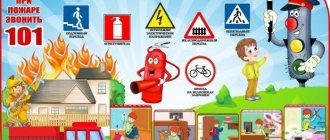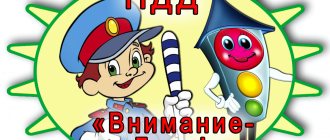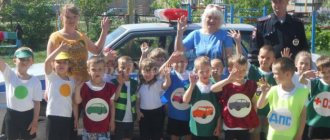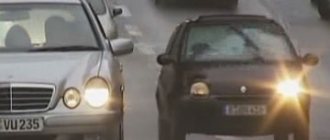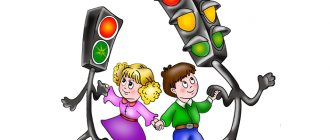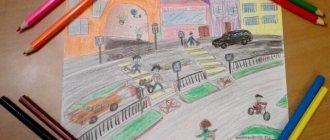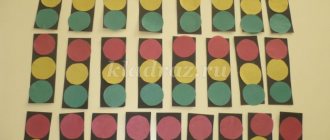Tasks and forms of work on traffic rules in preschool educational institutions
Tasks and forms of work in different age groups on traffic rules
Early age group Tasks: - introduce children to the vehicles of their immediate environment; - learn to distinguish and name some of them; - distinguish the parts of the machine and name them. Forms of work: - teacher’s story about types of transport (using illustrations and toys); - reading literary works; — examination of the paintings “City Street”, “Transport”; — role-playing game “We are drivers”; - acting out situations; — didactic game “Assemble a car.” Children should: - recognize some types of vehicles; - show the parts of the machine and name them. Group: junior Objectives: - introduce children to the operation of traffic lights; - form ideas about the street; — learn to distinguish between types of ground transport. Forms of work: - teacher’s story about types of transport (using illustrations); — targeted walk “Getting to know the street”; — reading poems by V. Lebedev-Kumach from the collection “About Smart Animals”; — examination of the paintings “City Street”, “Transport”; — role-playing game “We are drivers”; — viewing of puppet shows “Respect the traffic light”, “An incident in the forest”; — applications on the themes: “Fun Train”, “Traffic Light”; — targeted walk “Observing the operation of a traffic light”; — didactic game “Assemble a traffic light.” Children should: - know how a traffic light works (name its signals), at what signal it is possible to cross the roadway; — master the concepts: driver, passenger, pedestrian; use them in speech; — know the names of vehicles: passenger car; vehicles: truck, ambulance, fire truck; tram, bus, train; - have an idea of what a roadway or sidewalk is. Group: medium Objectives: - clarify children’s knowledge about the purpose of a traffic light; — introduce the classification of types of urban transport, develop skills of cultural behavior in transport; — expand the understanding of the street, roadway, provide basic knowledge about the rules of safe behavior. Forms of work: - story “The street on which the kindergarten is located”; - reading the works of S. Mikhalkov “My Street”, “Traffic Light”, M. Druzhinina “Our Friend the Traffic Light”; — targeted walk “Pedestrian crossing”; — viewing photographs of “Streets of our city”; — drawing “Truck”; — designing “Our Street”; — didactic game “Transport”; — viewing of puppet shows “Respect the traffic light”, “An incident in the forest”; - outdoor games to develop coordination of movements; — conversation “Let's be polite”; — games at the tabletop crossroads; — fairy tale game “Pedestrian ABC”; — puppet show “An Incident in the Forest”; — watching thematic cartoons. Children should: - name all the traffic lights and talk about their meaning: red, yellow - “stop”, green - “make sure it’s safe and go”; - learn different types of transport; be able to classify them: water, air, land; - name the rules of behavior in transport, on the street; - know where you can cross the roadway. Group: senior Objectives: - continue to consolidate and supplement the understanding of some traffic rules; — cultivate a culture of behavior on the street and in transport; — introduce children to road signs: “Pedestrian crossing”, “Pedestrian traffic is prohibited”, “Children”, “Tram stop”, “Bus stop”, “Medical aid station”, “Food station”, “Parking area”, “Road work", "Entry prohibited". Forms of work: - targeted walk “Road Signs”; - teacher’s story about the rules for safe street crossing; — watching the puppet show “Respect the traffic light”; - reading works on relevant topics; — examination of the painting “City Street”; — collective drawing on the theme “Street of our city”; — learning songs from the collection “School of Road Sciences”; — didactic games: “Walk around the city”, “Road signs”; — role-playing game “At the Crossroads”; — theatrical production “The Road to the Terem”; — solving problem situations at table crossings; — games at the training intersection; — watching thematic cartoons; — completing tasks in workbooks. Children must: - know the road signs: “Pedestrian crossing”, “Pedestrian traffic is prohibited”, “Children”, “Tram stop”, “Bus stop”, “Medical aid station”, “Food station”, “Parking area”, “ Road works", "Entry prohibited"; - have an understanding of the basic rules of the road; - recognize different types of transport, be able to explain their purpose; - name the rules of behavior in transport, on the roadway. Group: preparatory Tasks: - continue to introduce road signs: warning, prohibitory, informational signs; — improve the culture of behavior on the street and in transport; — introduce the work of a traffic controller. Forms of work: - examination of pictures with different types of transport, their classification: passenger, construction, military, etc.; — acquaintance with the work of adults — observation of the work of a traffic controller; — didactic games: “Road Signs”, “Put a Sign”, “Street”, “Pedestrian”; — targeted walk “Crossroads”; - compiling a story based on the painting “Policeman-Traffic Controller”; — obligatory conversation “The road is not a place for games”; — drawing on the topic “Remember the rules of the road”; — application on the theme “Road signs”; — design on the theme “Bus”; - reading works on relevant topics; — role-playing game “Traffic Controller”; — watching the puppet show “Respect the traffic light”; — examination of paintings and posters “Rules of conduct on the street”; — solving problem situations at table crossings; — games at the training intersection; — musical and gaming leisure “Remember the rules of the road!”; - campaign “Driver! Save my life!”; — sports leisure for parents and children “Visiting the traffic light”; - joint compilation of a collage by children and parents “My Yard”; — production of the “Family of Road Signs”; — solving puzzles and crossword puzzles “Road ABC”; — learning songs from the collection “School of Road Sciences”; — leisure time together with 1st grade students “Study the rules of the road”; — watching thematic cartoons; — completing tasks in workbooks; — conversation with a traffic police inspector. Children must: - be able to solve problem situations that arise on the roadway and in the yard; - recognize different types of transport, be able to classify: passenger, construction, military; - have an understanding of the work of the traffic controller and his functions; - be able to classify road signs: warning, prohibitory, informational. Information for teachers Before starting teaching preschoolers, teachers themselves need to know and follow the rules of the road. Therefore, the organization of consultations, workshops, and exhibitions of specialized literature is an integral part of the work on the prevention of child road traffic injuries in preschool institutions. Conducting competitions (“Designing a traffic corner for children”, “The best development of a lesson on teaching children the rules of safe behavior on the streets and roads of the city”, etc.) also contributes to the manifestation of creative activity and initiative of teachers. Be sure to involve traffic police inspectors in your classes, because they will be able to provide the most complete and reliable information about traffic rules, provide an analytical report on the state of urban transport and children's road traffic injuries. Road safety corners in preschool educational institutions
We recommend watching:
Role-playing game on traffic rules for the senior group Photo report of the holiday in the senior group on traffic rules Do-it-yourself didactic game on traffic rules for a kindergarten Summary of the GCD on traffic rules in the middle group on the topic: Road alphabet
Similar articles:
Layout for learning traffic rules with preschoolers
Scenario of a children's summer holiday on traffic rules in the 1st junior group with parents
Project on traffic rules in the senior preparatory group “Children and the Road”
Long-term work plan on the topic: “Education of the fundamentals of safe behavior in preschool children” with children 6-7 years old
A set of classes on road safety in kindergarten
Municipal budgetary preschool educational institution "Kindergarten No. 221"
A set of classes (direct educational activities) on Road Safety (middle age)
Compiled by: Peregudova L.I. Novokuznetsk city district 2017
September: “Getting to know the roadway.”
October: “Looking at a car, bus, tram”
November: “Meet guys, this is a traffic light.”
December: “Applique “Bus”.
January: “Pedestrian crossing.”
February: “Cat House. What kind of transport is there?
March: “I am a pedestrian.”
April: “Collective work “Our traffic light”.
May: “Collage “Streets of my city.”
A didactic manual for classes on traffic rules in kindergarten can be purchased at a specialized store - detsad-shop.ru
Getting to know the roadway
Program content: clarify and expand children’s ideas about the surrounding space; introduce children to the concepts of “roadway” and “sidewalk”, teach them to distinguish between them. Form the idea that cars move on the roadway, and pedestrians move on the sidewalks; give basic knowledge about the rules of behavior on the street.
Visual aids: layout of the roadway with markings and sidewalks with houses and trees; toys – cars, human figures; Parsley is a character present in every lesson of this cycle.
Activation of vocabulary: sidewalk, roadway, pedestrians, vehicles.
Progress of the lesson:
1. Vs: Guys, Parsley came to us today. He really wants to make friends with you. Let's say hello to him.
(Hello, Petrushka)
V-l: Parsley, guys, just like you, he wants to attend kindergarten, play with toys, go for walks, study in classes, and he really wants to start learning the rules of the road with you..
Look guys, what is this?
(street layout)
V-l: Correct. What's on this street?
(houses, trees, road)
V-l: And you know, guys, it turns out that the road consists of several parts. This is the sidewalk and roadway. Today I will tell you what it is and what it is intended for. A sidewalk, guys, is a path along which pedestrians walk. Who are pedestrians?
(people who move along the road on foot)
V-l: That's right, guys. The sidewalk is intended only for pedestrians and is separated by a curb from the roadway along which vehicles move. What vehicles do you know?
(cars, buses, trams, etc.)
Question: cars drive very fast and cannot stop instantly. Therefore, you need to be very careful and attentive and be sure to follow a few basic safety rules:
- never cross the road without an adult
- do not cross the road in front of a nearby vehicle
Vs: Do you remember, Petrushka? (shakes his head). That's how absentminded he is! Let’s repeat once again for Parsley what we learned today. What parts does the road consist of?
(sidewalk and roadway)
Q: Who walks on the sidewalk?
(pedestrians)
Q: What is the roadway intended for?
(for the movement of cars and other vehicles).
Q: Why do you always need to be very attentive and careful when crossing the road?
(because vehicles move very quickly and cannot stop instantly)
V-l: What great fellows you are, guys! Now Petrushka will never forget how to behave near the roadway. And in the evening, when you go home today, show mom and dad the sidewalk and roadway. Let's say goodbye to Parsley.
(Goodbye, Parsley!!)
“Examining a bus, car, tram.”
Program content: to form ideas about various types of transport: cars and trucks, buses, trams; teach to distinguish and name parts of a car (cabin, steering wheel, wheels, body, windows). Activate new words in children’s speech (cabin, steering wheel, wheel, passenger, driver, interior, rails). Explain the purpose of various types of vehicles.
Visual aids: illustrations depicting cars and trucks, buses, trams; Parsley.
Activation of the dictionary: cabin, steering wheel, wheel, body; passenger transport
Progress of the lesson:
1. Vs: Guys, look who came to us. Say hello to Petrushka.
(children say hello).
Vs: What interesting thing did you, Petrushka, bring us? What is shown in these pictures?
(bus, tram, car, truck)
V-l: How interesting! Do you know, Petrushka, what these vehicles are intended for? Do you guys know? Then I'll tell you this now. We will now look at these pictures one by one.
It turns out that all vehicles that move along the roadway differ not only in appearance but also in their purpose. There are cars designed to transport a small number of people (1-5). Look at what parts a car consists of. It has a steering wheel to steer the car; wheels on which the car moves along the roadway; the salon where the driver and passengers are located; windows - to look out onto the street. A passenger car is designed to transport a small number of people. This is a passenger vehicle.
But this is a truck. Look what it consists of?
(steering wheel, windows, wheels, body..)
V-l: Well done. But a truck is different from a car. A truck has a cabin - a place for the driver and a body - a device for transporting goods. A truck is designed to transport various goods - it is a cargo vehicle.
And what's that ?
(bus)
Look at the bus carefully. What does it consist of?
(interior, wheels, window, steering wheel, cabin...)
Do you know why the bus has such a large interior? Because the bus is designed to transport a large number of people.
And this, guys, is a tram. Look and tell me what the tram is designed for?
(for transporting a large number of people)
V-l: How did you guess?
(it has a large salon)
Q: What types of vehicles are buses and trams?
(passenger vehicles)
V-l: You see, guys, how many different vehicles move along the roadway and each has its own purpose, which we can determine by appearance.
“Hey guys, this is a traffic light.”
Program content: to form in children an idea of the traffic light and its purpose (regulating the movement of vehicles and pedestrians on the roadway). Introduce types and signals of traffic lights. Tell that a traffic light has 3 color signals that determine the actions of traffic participants; The traffic light for pedestrians has 2 signals. Learn to understand the meaning of red, yellow and green traffic lights; correctly understand pedestrian traffic light signals (a green walking man and a red standing man). Develop safe behavior skills on the road (you can cross the roadway only when the pedestrian traffic light permits.)
Visualization: layouts of transport and pedestrian traffic lights.
Progress of the lesson:
1. Vs: Today, guys, together with Petrushka, you will learn how to cross the roadway correctly, and therefore safely. It turns out that we have assistants who will always tell us where to cross correctly and safely. One of these helpers is a traffic light. (show traffic light layouts).
V-l: You all saw them near the roadway. Who knows what a traffic light is for?
(children's answers)
Vs: The traffic light, guys, regulates the movement of vehicles and pedestrians on the roadway. Therefore, there are two traffic lights - for vehicles and for pedestrians. To protect yourself, you need to know both of these traffic lights. A transport traffic light regulates the movement of vehicles only and does this with the help of three signals. These are three round windows of different colors. What colors are these?
(red, yellow and green)
Question: When a red signal is on at such a traffic light, it means that traffic is prohibited. The yellow signal asks us to be attentive and get ready. Green - allows the movement of cars and other vehicles.
(pedestrian traffic light demonstration)
Question: The traffic light intended for pedestrians looks a little different. Take a look and tell me how it differs from a transport one?
(has two signals)
V-l: Well done! There are only two signals at the pedestrian traffic light. This is a green walking man and a red standing one. What do you think these signals mean?
(a walking green man allows movement, and a standing red man prohibits movement).
Whew? How are these signals similar to traffic light signals?
(green color allows movement, red color prohibits)
Vl: Let's play the game "Traffic Light". I will show you different traffic lights one by one, and you will follow the following commands: a walking green man - we walk in place, a red standing man - we stand, hands on our belt. If I show you the traffic light signals, what will you do?
( stand)
V-l: Why?
(traffic traffic lights regulate the movement of vehicles only)
(we play 3-4 times).
V-l: Smart girls! So why do we need a traffic light on the roadway?
(regulates traffic and helps to cross the roadway safely if you follow his commands).
Vl: Remember this well and never forget.
Application "Bus".
Program content: fix the name of the bus parts (body, wheels, windows). Practice depicting an object from ready-made forms by gluing; orientation on a sheet of paper. Strengthen appliqué skills.
Visual aids: sample, illustration of a bus; individual kits with prepared parts for each child to complete the applique
Progress of the lesson:
V-l: Guys, today our friend Parsley is going to visit the forest animals. Let's make gifts for little squirrels, wolves and bunnies. I propose to give them bright, cheerful buses so that next time they can all come to visit us together.
V-l: Look, guys, what a wonderful bus you and I will get. What parts does it consist of?
(body, windows, door, wheels)
Q: What type of vehicle is a bus?
(passenger vehicle)
V-l: Why?
(it is designed to carry a large number of passengers)
V-l: Well done! For work we will need: half a landscape sheet, a body, 2 windows, 2 wheels and a door; glue stick and oilcloth.
First we glue the body to the center of the sheet. We glue the wheels to the lower edge of the body. We will place the door in the center of the body. And lastly, we glue the windows.
(children perform applique).
Vs: Pick up your leaves, guys. Look, Petrushka, what a wonderful bus fleet we have. How many bright and beautiful buses we will give to the little animals.
"Crosswalk".
Program content: introduce children to zebra road markings and pedestrian crossing signs; continue to develop the skill of safe behavior on the roadway, crossing only at zebra crossings and only at the permissive traffic light signal.
Visual aids: roadway layout, Pedestrian crossing sign
Progress of the lesson:
V-l: Today, guys, we will learn how to cross the roadway correctly and safely. Do you already know who is helping us with this?
( traffic light).
Q: Which traffic light regulates pedestrian traffic?
(pedestrian with two signals)
Question: At what traffic light can you cross the roadway?
(only for the permission signal - walking green man)
V-l: Well done! Right! But it turns out that there are also clues on the roadway that will help you safely cross to the other side of the roadway. This, guys, is road markings for pedestrians. See those white stripes? This is a pedestrian crossing; it is through it that you can cross the roadway. It is also called “zebra”. Why do you think?
(the stripes are similar to the coloring of a zebra's skin).
V-l: Next to this marking they always install a road sign like this.
(Pedestrian crossing sign is shown).
Vl: It means that in this place it is safe to cross the roadway.
Look at our layout. Show the zebra crossing and the pedestrian crossing sign.
(children complete the task).
V-l: Well done! Now let's arrange the figures of pedestrians who are crossing the roadway.
(children arrange).
V-l: Well done! You did great! Now you can tell others how to cross the roadway correctly and therefore safely. How?
(at a pedestrian crossing and only at the permissive traffic light signal).
Well done boys!
" Cat house. »
Program content: introduce children to types of special transport. To form an idea of the purpose of special transport (a fire truck goes to put out a fire, an ambulance goes to help a sick person). Consolidate knowledge about special services and their purpose, remember emergency numbers 02, 01, 03.
Visual aids: a set of dolls and decorations for the fairy tale “Cat’s House”; toys or illustrations of special purpose vehicles - ambulance, fire, police.
Preliminary work: reading and showing the fairy tale “Cat’s House”, conversation about the professions of fireman, policeman, doctor.
Progress of the lesson:
Vl: Guys, today Petrushka brought you and me a telegram, it was sent by kittens from the fairy tale “Cat’s House”. Let's quickly open it and read what happened. (the teacher opens the telegram and reads)
V-l: This is what is written here: “Tili-bom, tili-bom, the cat’s house is on fire! The cat jumped out and sprained its leg... Help us, guys! We need to put out the fire, treat the cat’s paw, catch the hooligans who set the cat’s house on fire.” We need help, guys...What to do, how to be? How can we put out the fire?
(you need to call the firefighters to put out the fire by calling 01).
V-l: Of course, that’s right, guys. And you know, firefighters have their own special car in which they go to fires, like this. That's what it's called - a fire truck.
(demonstration of a car model or its illustration).
V-l: Look how bright and red it is. He also turns on a loud siren so that other drivers will let him pass on the road when firefighters are on their way to put out a fire. Well, the fire seems to have been sorted out. Write a reply telegram, Petrushka, that you need to call the firefighters by phone 01. What else happened to them, guys?
(the cat sprained its paw)
V-l: Exactly! How to be? What do you guys need to do?
(call 03 for an ambulance so that a doctor can come and help the cat)
V-l: What great guys you are! Do you understand, Petrushka, how to act? How will the doctor arrive? And the doctor will arrive in a special car called an ambulance. Look at him carefully.
(demonstration of a car model or its illustration).
Question: You see, all ambulances have a red cross on them - this is a sign of medicine. And just like a fire truck, the Ambulance also has a sound siren, which other drivers hear and allow the ambulance to pass on the road. Then the ambulance arrives without delay
to the patient, and the doctor provides him with the necessary medical care. So write, Parsley, “Call an ambulance for the cat.” Well, have you resolved all the issues, Petrushka? Why not everything? What else is left? Guys, what else did the kittens ask for?
(help them find and detain the hooligans who set the cat's house on fire).
V-l: Where should we turn now, guys? Who can help us?
(you need to contact the police, call number 02)
V-l: Of course! Well done boys! After all, the police keep order and catch criminals and hooligans. You know, guys, the police also have their own special car. Here it is. (demonstration of a car model or its illustration). You see, it depicts the symbols of the police. This car cannot be confused with any other. Write, Petrushka, let them call the police on phone 02. Did you write? Now we’ll send a telegram to the kittens, you take it to the post office. And the guys and I will repeat what types of special vehicles we met today?
(fire truck, ambulance and police car)
V-l: Wonderful. Tell me, in what cases do these company cars need to be called? When do they arrive?
(the fire department is to put out the fire, the ambulance is going to the patient, and the police is to search for or detain criminals)
V-l: What great guys you are! Remember the telephone numbers of the special services. You can always call them and they will help if trouble happens. Fire service - 01, ambulance - 03, police - 02.
"I am a pedestrian."
Program content: teach the rules of behavior on the roadway (be attentive, stop and look around before crossing; hold an adult’s hand tightly, cross the roadway only at a zebra crossing and only at a traffic light).
Visibility: Medal for each child “I am a pedestrian.”
Progress of the lesson:
1. Vs: Today, guys, our Petrushka is going to visit the dolls. On the way, he will have to cross the roadway. Let's check if our Parsley remembers the rules of safe behavior. Tell us, Petrushka, what needs to be done before you start crossing the roadway? Do not you know? Maybe the guys can give you some advice?
(You need to stop and look around carefully)
V-l: Of course. Tell us, Petrushka, at what point can you cross the roadway?
(Petrushka replies that at any and any traffic light)
V: Right, guys? Of course not!! Under no circumstances should you cross the roadway like this. How is it necessary?
(you need to cross the roadway only along the zebra crossing and only when the traffic light permits - green walking man)
Q: Why is it necessary to follow these rules?
(because the car is driving very fast and will not be able to stop right away)
V-l: Well, how can we let you go alone? You forgot all the rules that we taught. If you really need it, ask an adult to accompany you, mom or dad. And when you cross the roadway, hold the adult’s hand very tightly. Do you understand, Petrushka?
(nods).
V-l: And the guys and I will once again repeat for you the rules for safely crossing the roadway. What should you do before you start crossing the road?
(you need to look around carefully)
Q: In what place and at what traffic light can you cross?
(only at a pedestrian crossing and at a traffic light signal - a walking green man)
V-l: What great fellows you are! For the fact that you know very well the rules of pedestrian behavior on the road, today I am rewarding all of you with a special badge - the “I am a pedestrian” sign.
(children receive medals)
V-l: And you, Petrushka, when you remember the rules of the road, you will also receive such a medal. Now go visit, but remember all the rules that we told you today.
“Collective work “Our traffic light”.
Program content: repeat and reinforce the purpose of the traffic light, types of traffic lights and the meaning of their signals. Learn to work together, together. Strengthen the skills of safe behavior on the road.
Visual aids: illustration of a traffic light.
Equipment: prepared traffic light bases (2 rectangular prisms); a set of circles for traffic lights; applications of transport and pedestrian traffic lights with blue, brown and yellow signal windows, with windows of a blue walking man and a standing green man.
Preliminary work: reading the poem “Traffic Light”.
Progress of the lesson:
V-l: Guys, Parsley came to visit us again today. Say hello to him.
V-l: What do you have, Petrushka? Guys, what is this?
(demonstration of a traffic light with incorrect color boxes)
V-l: Guys, please remind me what a traffic light is for?
(it regulates the movement of vehicles and pedestrians on the road).
Vs: Guys, look, did Petrushka make the traffic lights correctly?
( No)
V-l: Why is it wrong?
(mixed signals)
Q: What colors are traffic light signals?
(red, yellow and green).
Q: What do they mean?
(red - prohibits movement, yellow - attention, green - allows movement of vehicles).
V-l: And at the pedestrian traffic light?
(green walking man and standing red man)
Q: What do they mean?
(a green walking man allows pedestrian movement, and a red standing man prohibits it)
V-l: Well done, guys!!! And you, Petrushka, don’t be upset. Now we will all make the right traffic lights together. I have these blanks for traffic lights. All we have to do is glue his eyes - signals.
(prepared circles are glued together with the children).
V-l: Look what wonderful traffic lights we have made!! Let's put them in our traffic corner. And you, Petrushka, remember what traffic lights have signals and what they mean...
« Collage “Streets of my city”.
Program content: to generalize and consolidate children’s knowledge about safety when crossing the roadway, acquired during the year; identify the level of mastery of the material. Continue to work on developing the skill of safe behavior on the roadway.
Preliminary work: tint whatman paper.
Equipment: Tinted Whatman paper; silhouettes of vehicles, trees, pedestrians, traffic lights, pedestrian crossing sign, glue stick (according to the number of children).
Progress of the lesson:
1. Vs: Guys, today Parsley has prepared a surprise for you. This is a collage, a painting where silhouettes of various objects are glued onto a painted background. Parsley prepared the background, but didn’t have time to glue the figures. Let's finish this picture together. Look, guys, what did Petrushka want to portray?
(street of our city)
V-l: What should be placed on our street? What should be on it?
(houses, trees, sidewalk, roadway, pedestrians, vehicles)
V-l: Let's remember what kinds of vehicles there are?
(trucks, passenger, cars)
V-l: Well done! Show me where to place houses and trees?
Let's glue them.
(glue figures of pedestrians to houses and trees)
V-l: Where can we glue the figures of pedestrians?
(on the sidewalk, because people move on sidewalks)
Q: What is the roadway intended for?
(for vehicle movement)
Vl: So, we can place the figures of vehicles on the roadway. Show me it in our picture.
(1-2 children show).
Q: Take vehicle figures, name them and place them on the roadway.
(children name the type of vehicle chosen and glue their silhouettes to the roadway).
Vs: Guys, tell Petrushka, can pedestrians move along the roadway?
(yes, when they cross from one side of the street to the other)
V-l: Correct! But what rule must be followed to safely cross the roadway?
(cross the road only at a pedestrian crossing and only when the traffic light signal permits)
Q: What helps us find out where the pedestrian crossing is on the road?
(zebra markings and pedestrian crossing sign)
Q: Find the “zebra” markings in our picture and glue the “pedestrian crossing” sign and figures of pedestrians onto the markings next to it.
(children glue)
Vs: Guys, Petrushka didn’t understand what “permissive traffic light signal, traffic light signal” means. Tell us what a traffic light is and why it is needed on the roadway.
(a traffic light is a device that regulates the movement of pedestrians and vehicles. A transport traffic light has 3 signals, red - stand, yellow - get ready, green - allows movement. A pedestrian traffic light has two signals; a green walking man allows movement, a red standing one prohibits)
V-l: What great fellows you are! Let's put traffic lights on our collage.
(children glue).
Vl: Look, guys, what a wonderful collage we have made.
